Recent Articles
Popular Makes
Body Types
2023 Ford Escape Road Test and Review
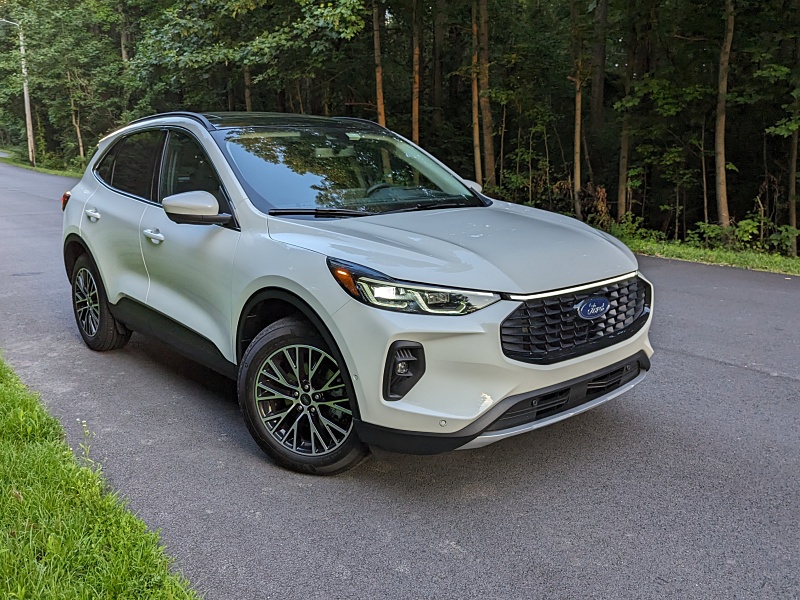
Photo by Brady Holt
More than two decades ago, the Ford Escape was one of the first compact crossover SUVs, and it has been among the segment’s best-sellers for most of that time. But the latest Escape, introduced in 2020, has captured a smaller slice of that market. Its sales have been more in the field of Kia and Mazda than Toyota and Chevrolet.
This year, Ford rolled out its solution: a redesigned front end and an overhauled, higher-tech dashboard. We just spent a week testing the updated 2023 Ford Escape to see if it has earned a second look amid intense competition. Keep reading to learn more about its pros and cons so you can see if it’s the right small SUV for you.
Wide Range of Models
A key asset to the 2023 Ford Escape is a wide range of models. These include four different powertrains (two powerful turbocharged four-cylinders and two fuel-sipping hybrids) and trim levels that vary from a lightly equipped base version to ones that include a variety of luxury add-ons.
The base Escape starts at $28,000, which isn’t dirt-cheap but undercuts some rivals despite including an 8-inch infotainment touchscreen and blind-spot monitoring – two notable items that cost extra on some rivals. A bigger 2.0-liter engine arrives at the $34,040 ST-Line Select model, just $1,500 more than an equivalently equipped model with the standard 1.5-liter. The gas-electric hybrid engine is available starting on the mid-trim ST-Line model at $33,340 (a $3,000 premium over an equivalently equipped gas model). And a plug-in hybrid, or PHEV, starts at $40,500; that’s about $4,500 more than a comparable non-plug-in hybrid, but it’s offset with a $3,750 federal tax credit. All-wheel drive costs about $1,500 extra with the base engine and the standard hybrid powertrain. It comes standard with the 2.0-liter gas engine and isn’t available on the PHEV, which is front-wheel drive only.
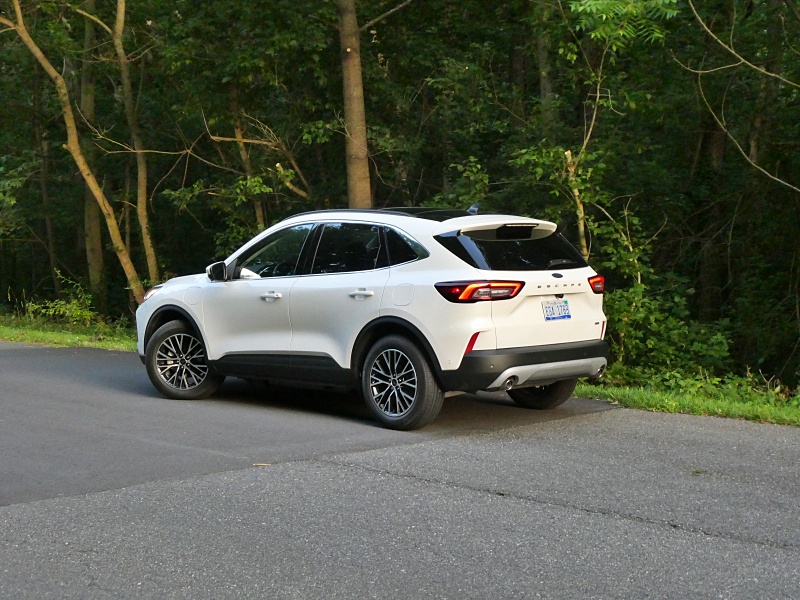
Photo by Brady Holt
Sharper New Looks
The 2020 Ford Escape debuted with a round, soft, friendly face. Some buyers found it endearing. But in case this was the reason for sluggish sales, Ford toughened it up for 2023.
The Escape now has slimmer, pointier headlights for a sportier, more purposeful look. The grille is smaller and more squared-off as well. And upper trim levels, including our PHEV test vehicle, include an LED lightbar atop the grille. Still, this is a gentle-looking SUV overall. It doesn’t have sharp, futuristic creases or a tough-truck attitude. It looks small and unassuming, even though it’s the same size as its competitors. Ford saves its rugged design cues for the boxy, retro-styled Bronco Sport, which has the same mechanical underpinnings as the Escape.

Photo by Brady Holt
Big New Touchscreen
The Escape’s dashboard is friendly and contemporary without being aggressively cutting-edge. That’s especially the case with base models that get last year’s 8-inch infotainment touchscreen, though all models now include a digital gauge cluster.
Our test vehicle included the new 13.4-inch touchscreen that rockets to the top of the class in size. We generally liked it. It may look out of proportion in pictures, but in person, we thought Ford made good use of the screen’s real estate. The Escape presents various information clearly and without clutter, with fonts big enough that you don’t have to squint. However, the screen does swallow up climate functions, which base models handle with simpler buttons and knobs. Just don’t count on a luxury feel like you’d get in a top-trim Honda CR-V or Nissan Rogue. It’s not junky, but the plastics and even the available leather upholstery felt budget-grade to us.
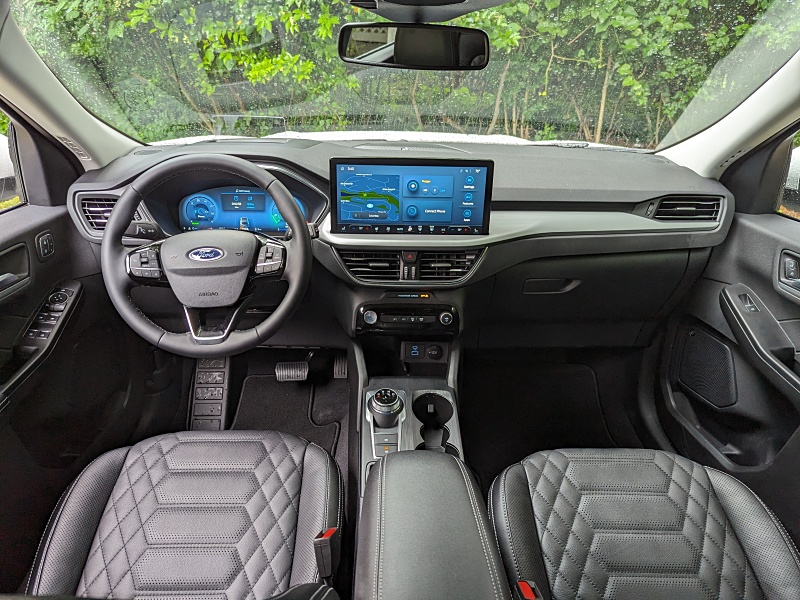
Photo by Brady Holt
Cozy But Practical
The compact crossover is such a popular vehicle because of its useful size: not overly bulky, but big enough to carry people and a fair bit of cargo. The Escape meets this standard. Adults can fit in both the front and the back, especially if you slide back the fore-aft-adjustable rear seat. For cargo, there’s 33.5 cubic feet behind the backseat in its maximum-legroom position, 37.5 cubic feet if you’ve slid it forward, and 65.4 cubic feet if you’ve folded it down.
For both passenger and cargo volume, the Escape trails its roomiest competitors but will be big enough for many folks’ needs. Some will also appreciate its cozier feel. We wish it offered ventilated front seats like a few rivals, though, especially on fully optioned models that top $40,000. It does have one functionality advantage over nearly all similarly sized rivals: 2.0-liter models can tow up to 3,500 pounds. Even the 1.5-liter can tow 2,000 pounds, while the hybrid can tow up to 1,500 pounds. Note that the Escape is also roomier than its Ford Bronco Sport cousin.
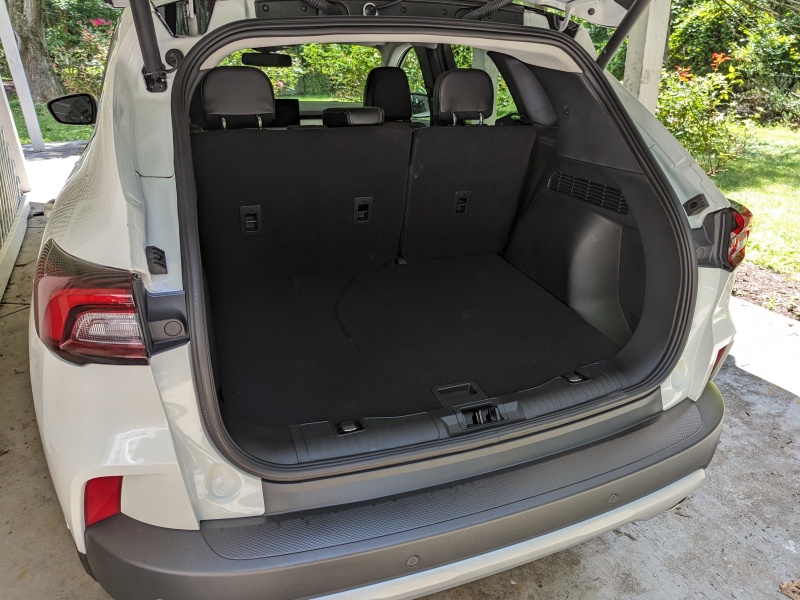
Photo by Brady Holt
Peppy Turbo Engines
We mentioned that the Escape has a choice of four engines. And we like driving each of them. We’ll start off with the most affordable engine: a 1.5-liter three-cylinder turbo that makes 180 horsepower and 199 lb-ft of torque. We came away impressed with both the peppiness and the quiet but assertive growl of the last three-cylinder Escape we tested. It gets an EPA-estimated 27 mpg in the city, 34 mpg on the highway, and 30 mpg combined with front-wheel drive and about 2 mpg less with all-wheel drive, and we averaged 29 mpg in an AWD test vehicle. That’s about average for a compact crossover.
What’s above average is the Escape’s optional 2.0-liter four-cylinder. It makes 250 horsepower and 280 lb-ft of torque, more than you’ll find in many luxury SUVs this size. And although Ford recommends premium fuel for best performance, it’s also engineered to run just fine on lower-cost regular. It doesn’t swill the stuff, at least, averaging an EPA-estimated 23 mpg city, 31 mpg highway, and 26 mpg combined.
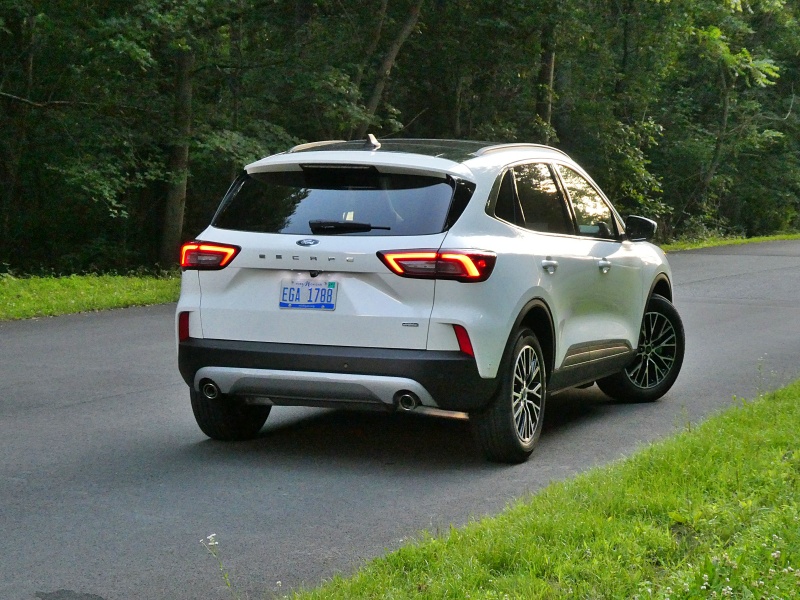
Photo by Brady Holt
Two Hybrid Options
Next we come to the fuel-sipping Escapes: the Escape Hybrid and the Escape PHEV. The Escape Hybrid pairs a 2.5-liter non-turbo gasoline engine with an electric motor for a total output of 192 horsepower. It’s no powerhouse, but it avoids feeling sluggish, and the engine doesn’t sound too harsh when it’s running. However, the trip computer told us that we only needed the gas engine for about 56 percent of our driving time when we last tested one. These days, it gets an EPA-estimated 42 mpg city, 36 mpg highway, and 39 mpg combined with either front- or all-wheel drive; our test vehicle averaged 42 mpg.
We most recently tested the PHEV. If you plug it into the wall, it promises an estimated 37 miles of fully electric driving before you need the gas engine. That’s enough to cover many folks’ daily commutes and errands. And if the engine is needed, it still gets an estimated 40 mpg. In our testing, our ranges varied from 36 to 42 miles, and we averaged about 43 mpg without using our electric charge.
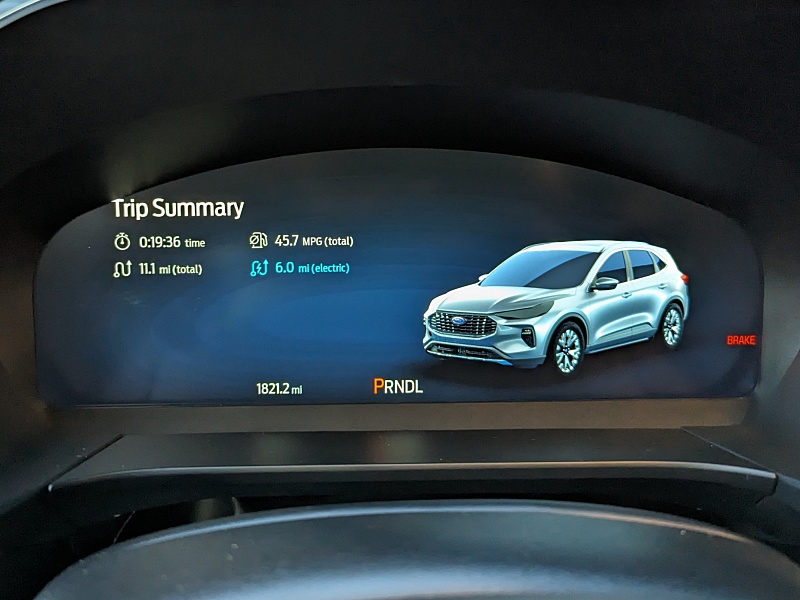
Photo by Brady Holt
Polished Ride and Handling
While the Ford Escape isn’t the sportiest, most engaging vehicle on the market – or even in its market class – we found it an easy car to drive either fast or slow. Extra-light low-speed steering makes it easy to park, while it firms up nicely as you pick up speed. Our PHEV test vehicle wore tires optimized for efficiency more than maximum grip, but we’ve enjoyed higher handling limits in previous Escapes we've driven.
Despite its agility, while you’ll find a few softer-riding competitors, we had no complaints with the Escape’s firm, composed ride. You’ll notice bumps, but this Ford passes over them with minimal drama and moves on from them quickly. This SUV’s safety and driver-assistance features also make it easier to drive. Forward automatic emergency braking, lane-keeping steering assistance, and blind-spot monitoring are all standard equipment on every Escape. All but the base model either includes further features or has them available as an option: adaptive cruise control with stop-and-go capabilities, lane-centering steering, and evasive steering assistance.
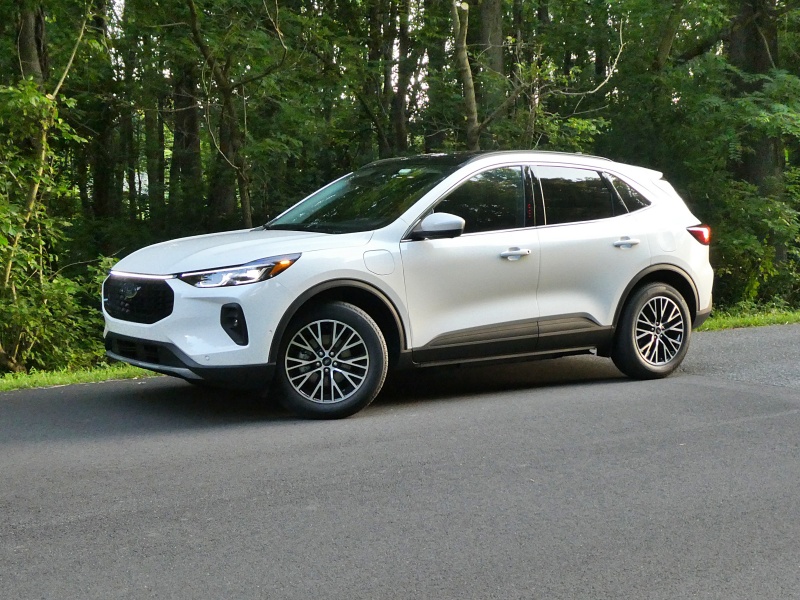
Photo by Brady Holt
Wide Range of Competitors
The Escape faces a wide range of competitors in the compact crossover class. Three of them match the Escape’s range of gasoline, hybrid, and plug-in hybrid powertrains: the Hyundai Tucson, its Kia Sportage cousin, and the Toyota RAV4. They’re all roomier than the Escape, too. But the Ford has sportier handling and quicker, quieter acceleration from even its base gasoline engine – to say nothing of the uplevel 2.0-liter.
Another of our favorites in this class is the Honda CR-V, available in gas and hybrid forms (but not as a PHEV). Roomy, well-finished, and sharp-handling, it feels solidly built and upscale, yet also incredibly functional. It comes up short for modest speed, small touchscreens, and prices on the high side. If you’re looking for just gasoline, we love the quick, agile, spacious, and economical Nissan Rogue, but it lacks a hybrid version. When crisp driving manners are a priority over a spacious interior or great gas mileage, the Dodge Hornet and Mazda CX-5 and CX-50 are leaders. And if you’re looking to tow, only the CX-50 and RAV4 can match the Escape’s capacity.
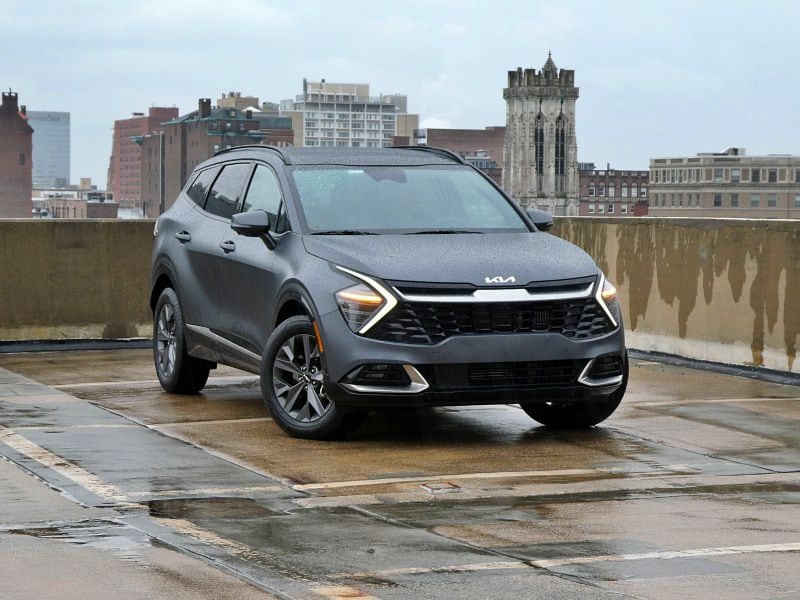
Photo by Brady Holt
Final Thoughts
There’s a lot to recommend in the 2023 Ford Escape. It can be the compact crossover for you if you like a powerful engine and sporty handling. Or it’s the one for you if you want a crossover that’s usefully roomy without looking or feeling like a cavernous box. Or it’s your way to have an affordable, economical, easy-to-drive SUV that can still tow. Or maybe it’s your path to a relatively affordable PHEV, since none of the Escape’s competitors qualifies for a tax credit. Or maybe you just love that great big touchscreen.
The updated Escape hasn’t become a class leader for interior spaciousness or decor. The styling will still be too tame for some, even after the fresh updates. And we’ll note that although we had no complaints during our test, some folks have hated the Escape’s base three-cylinder engine. But overall, it’s a well-rounded crossover that could be the perfect fit for the right buyer.
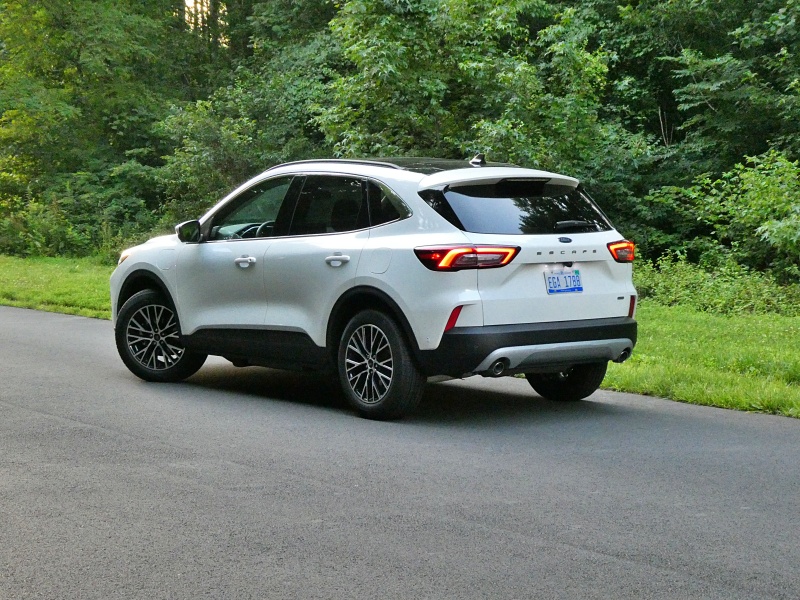
Photo by Brady Holt